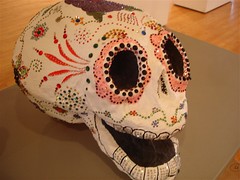Day of the Dead (Spanish: Día de los Muertos) is a holiday celebrated by many in Mexico and by some Mexican Americans living in the United States and Canada, says Wikipedia.
The holiday focuses on gatherings of family and friends to pray for and remember friends and family members who have died. The celebration occurs on November 2 in connection with the Catholic holidays of All Saints' Day (November 1) and All Souls' Day (November 2).
Traditions connected with the holiday include building private altars honoring the deceased using sugar skulls, marigolds, and the favorite foods and beverages of the departed and visiting graves with these as gifts.
Scholars trace the origins of the modern holiday to indigenous observances dating back thousands of years and to an Aztec festival dedicated to a goddess called Mictecacihuatl. In Brazil, Dia de Finados is a public holiday that many Brazilians celebrate by visiting cemeteries and churches. In Spain, there are festivals and parades, and, at the end of the day, people gather at cemeteries and pray for their dead loved ones.
Plans for the day are made throughout the year, including gathering the goods to be offered to the dead. During the three-day period, families usually clean and decorate graves;[2] most visit the cemeteries where their loved ones are buried and decorate their graves with ofrendas ("offerings"), which often include orange mexican marigolds.
Toys are brought for dead children (los angelitos, or "the little angels"), and bottles of tequila, mezcal or pulque or jars of atole for adults. Families will also offer trinkets or the deceased's favorite candies on the grave.
Ofrendas are also put in homes, usually with foods such as candied pumpkin, pan de muerto ("bread of the dead"), and sugar skulls and beverages such as atole. The ofrendas are left out in the homes as a welcoming gesture for the deceased.[2] Some people believe the spirits of the dead eat the "spiritual essence" of the ofrendas food, so even though the celebrators eat the food after the festivities, they believe it lacks nutritional value. Pillows and blankets are left out so that the deceased can rest after their long journey.
In some parts of Mexico, such as the towns of Mixquic, Pátzcuaro and Janitzio, people spend all night beside the graves of their relatives. In many places, people have picnics at the grave site as well.
Some families build altars or small shrines in their homes;[2] these usually have the Christian cross, statues or pictures of the Blessed Virgin Mary, pictures of deceased relatives and other persons, scores of candles and an ofrenda.
A common symbol of the holiday is the skull (colloquially called calavera), which celebrants represent in masks, called calacas (colloquial term for "skeleton").
La Calavera de la Catrina ("calavera of the female dandy") is a parody of a Mexican upper-class female. The striking image of a costumed female with a skeleton face has become associated with the Day of the Dead, and Catrina figures often are a prominent part of modern Day of the Dead observances.
skip to main |
skip to sidebar
For students and parents who love education and exploration of the social sciences . . .
Search This Blog
Followers
Blog Archive
-
▼
2010
(346)
-
▼
October
(36)
- A decorated skull mask to mark the Nov 1 & 2 celeb...
- The Windy City and the Midwest quiz
- How to ace geography in the second half of the sem...
- NYC: learning the Big Apple through Broadway lyrics
- The Northeast states: New England and the Mid-Atla...
- Yankees: Massachusetts and the New England states
- Chicago's entertainment queen: Oprah Winfrey
- Looking Down 1,400 Ft From the "Ledge" in the Will...
- Impoverished Southerners moved to the Midwest for ...
- Chevy Volt Coupe: will such new-tech cars help res...
- Class of 2014 will plant 35 crepe myrtles on Th, F...
- The ginormous crop of the Midwest: corn
- Two significant, historic Chicago businesses: Sear...
- Quiz next class on Chicago, the Midwest and Los An...
- 59 Cadillac De Ville: emblem of the era when autos...
- The 12 states of the Midwest region of the US
- Muddy Waters: Mississippi to Chicago
- The Midwest and the crossroads city called Chicago
- Getting to know Chicago and comparing it to Los An...
- Luis Von Ahn: digital pioneer from Guatemala, but ...
- Indie comparison essay: Chicago and New Orleans
- Notes on a Presentation on Rural India by teacher ...
- Opportunity for exploration and service: Red River...
- Magnet Quiz, 9/15: 5 themes of Geography and S-B g...
- What the open-source smart phone will do to the wo...
- Sources of US wealth? Extensive resources and more
- California Dreamin' / Summary quiz
- A talented Californian who has touched our lives v...
- Myspace.com: HQ in Silicon Valley? Answer: No; Bev...
- One of the Bay Area's most successful artists: mov...
- Open notes Quiz on California Th/Fri and a map qui...
- Aztecs and Mayans: an intro to Mexico
- Does using Google improve or weaken the brain? See...
- Geo students will present an art, dance and food D...
- Indie comprison essay: Pierre Omidyar and Steve Jobs
- Open notes, mult-choice quiz on California notes f...
-
▼
October
(36)

